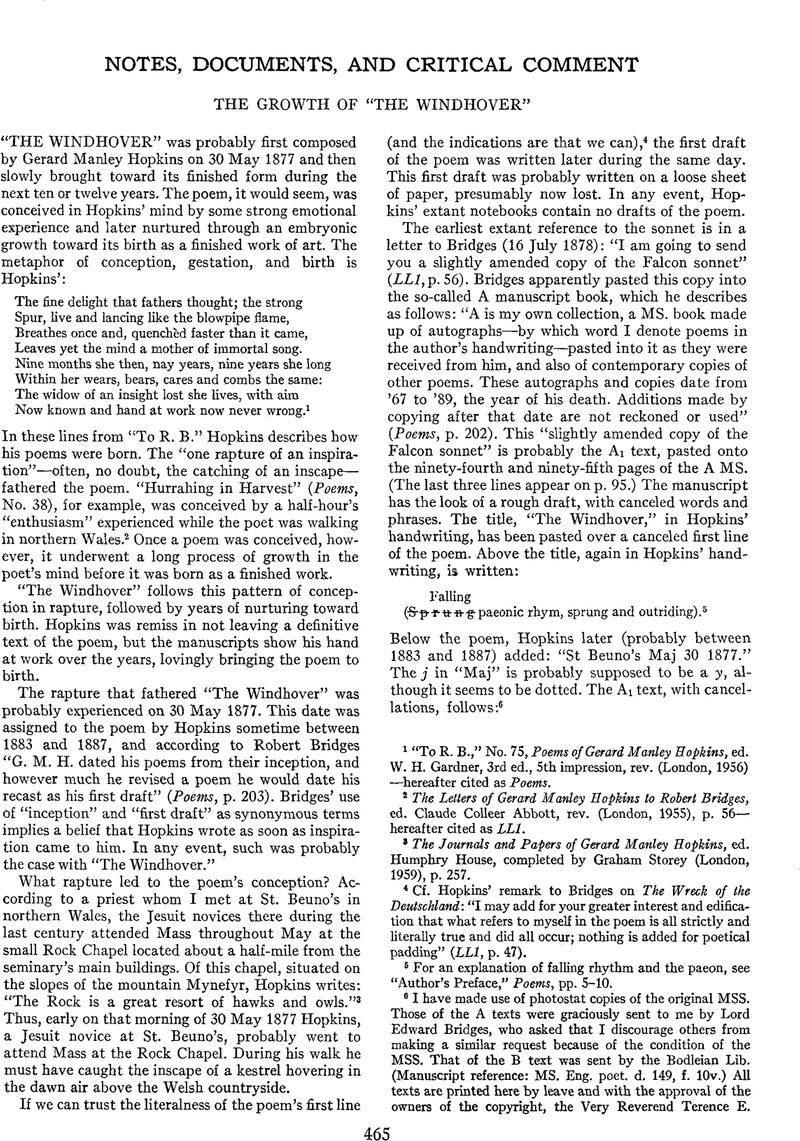Article contents
The Growth of “The Windhover”
Published online by Cambridge University Press: 02 December 2020
Abstract

Information
- Type
- Notes, Documents, and Critical Comment
- Information
- Copyright
- Copyright © Modern Language Association of America, 1967
References
Note 1 in page 465 “To R. B.,” No. 75, Poems of Gerard Manley Hopkins, ed. W. H. Gardner, 3rd ed., 5th impression, rev. (London, 1956) —hereafter cited as Poems.
Note 2 in page 465 The Letters of Gerard Manley Hopkins to Robert Bridges, ed. Claude Colleer Abbott, rev. (London, 1955), p. 56—hereafter cited as LL1.
Note 3 in page 465 The Journals and Papers of Gerard Manley Hopkins, ed. Humphry House, completed by Graham Storey (London, 1959), p. 257.
Note 4 in page 465 Cf. Hopkins' remark to Bridges on The Wreck of the Deutschland: “I may add for your greater interest and edification that what refers to myself in the poem is all strictly and literally true and did all occur; nothing is added for poetical padding” (LL1, p. 47).
Note 5 in page 465 For an explanation of falling rhythm and the paeon, see “Author's Preface,” Poems, pp. 5–10.
Note 6 in page 465 I have made use of photostat copies of the original MSS. Those of the A texts were graciously sent to me by Lord Edward Bridges, who asked that I discourage others from making a similar request because of the condition of the MSS. That of the B text was sent by the Bodleian Lib. (Manuscript reference: MS. Eng. poet. d. 149, f. 10v.) All texts are printed here by leave and with the approval of the owners of the copyright, the Very Reverend Terence E. Corrigan, S.J., and the Society of Jesus. The Oxford Univ. Press has also given its permission to quote the poem.
Note 7 in page 466 W. H. Gardner, Gerard Manley Hopkins (1844–1889): A Study of Poetic Idiosyncrasy in Relation to Poetic Tradition, i, 2nd ed., rev. (London, 1948), p. 94, n., in both A1 A2. After l. 6 the same person has written: = A. After l. 9 he has written, A1 A2 and drawn a line pointing to the space between plume and here. Apparently the same person has scanned ll. 2, 3, 12, and 14 as follows: dom of daylight's dauphin, dapple-dáwn-drawn Falcon, in his riding Of the rolling level úndernéath him steady áir, & stríding No wónder of it: shéer plód makes plóugh down síllion Fall, gáll themsélves, & gásh góld-vermílion.
Note 8 in page 466 In the B text someone (the handwriting resembles neither Hopkins' nor Bridges') has written in the margins. After l. 5 a circle has been drawn after swing followed by:
Note 9 in page 467 The handwriting of the B revisions and corrections is neater than that of the A2 changes, the outriding loops under there (l. 4) and the achieve of (l. 8) are included in B but not in A2, and the capital O of of in l. 2 has been corrected to lower case in B but not in A2.
Note 10 in page 468 Cf. a similar effect in the final line of “Hurrahing in Harvest.”
- 1
- Cited by

